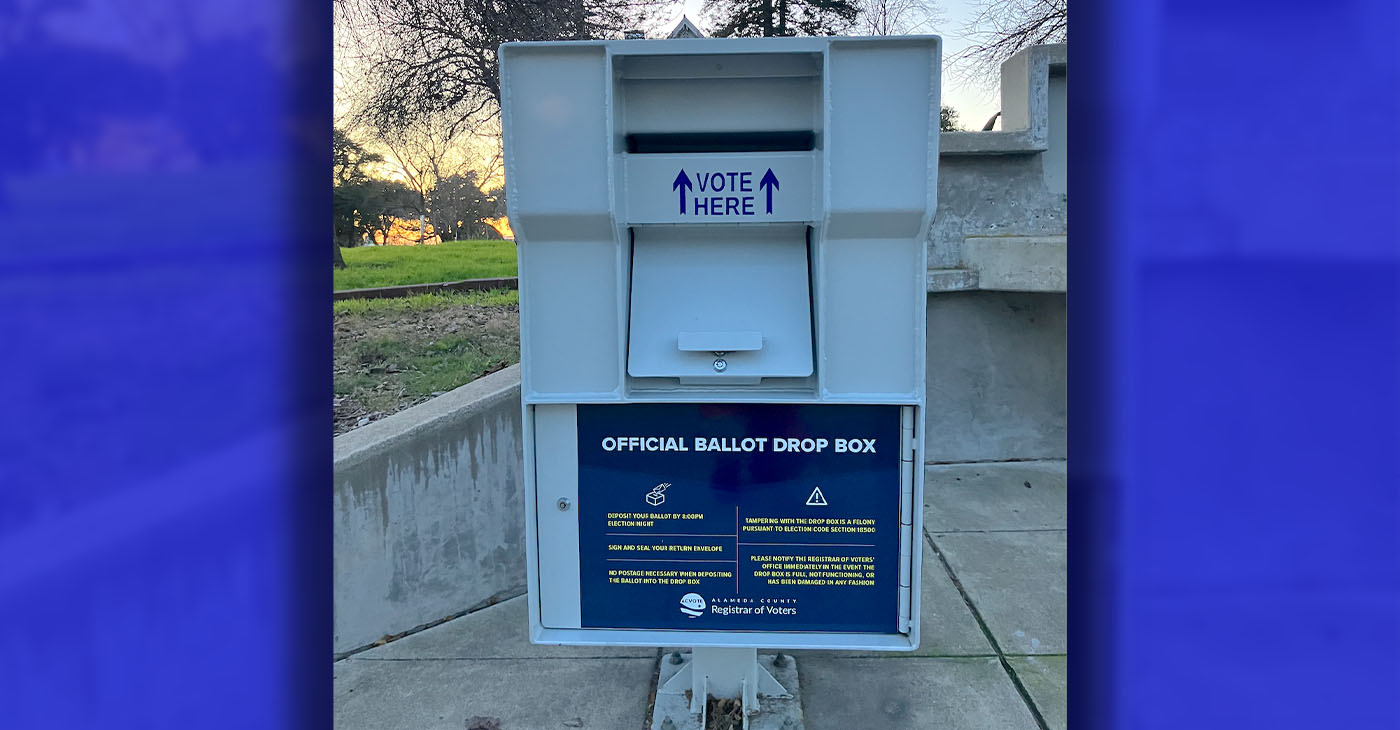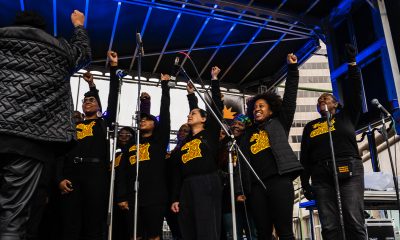Bay Area
Who Are the Top Donors in the Alameda County District 5 Supervisor’s Race?
District 5 covers West and North Oakland and includes Emeryville, Berkeley, Piedmont and Albany. The five-member Board of Supervisors sets the county’s budget, governs its unincorporated areas, oversees the sheriff, Alameda Health System, and the mental health system. Voting in this election has already begun. Most of those living in the district will have been mailed paper ballots. Residents can also vote in person on March 5, the last day voting is open. If no candidate gets more than half of the votes, the top two candidates will face off in the general election in November.

About $342,500, a little less than half of the approximately $705,000 raised in the race so far, has come from just 30 sources.
By Zack Haber
Nine candidates are running to represent District 5 on the Alameda County’s Board of Supervisors.
District 5 covers West and North Oakland and includes Emeryville, Berkeley, Piedmont and Albany.
The five-member Board of Supervisors sets the county’s budget, governs its unincorporated areas, oversees the sheriff, Alameda Health System, and the mental health system.
Voting in this election has already begun. Most of those living in the district will have been mailed paper ballots. Residents can also vote in person on March 5, the last day voting is open. If no candidate gets more than half of the votes, the top two candidates will face off in the general election in November.
Candidates in Alameda County are required to report all of their campaign donations. The public can search these filings through an online portal.
Looking through the county’s campaign finance reports, we found that residents, businesses and other organizations, such as unions, have donated around $705,000 in total to all candidates as of Feb. 13. In three cases, candidates donated to their own campaigns, but we excluded these figures.
Of the nine candidates, John Bauters, the former Emeryville Mayor and current City Councilmember, has raised the most, about $167,500. Alameda County Board of Education Trustee Ken Berrick has raised about $157,500. Piedmont resident and East Bay Rental Housing Association board member Chris Moore has raised about $129,000. Oakland City Councilmember Nikki Fortunato Bas has raised about $130,000; and Berkeley City Councilmember Ben Bartlett raised about $103,500.
The other candidates, Omar Farmer, Gregory Hodge, Gerald Pechenuk and Lorrel Plimier have all raised much less than the other candidates. So far, Hodge has raised about 11,500 and Plimier has raised about $5,500. Farmer and Pechenuk haven’t reported receiving any campaign donations.
While there were over 525 donations to candidates in total, of these, about $342,500 or a little less than half of the about $705,000 in total donations, came from just 30 sources. For the purposes of this article, we’ve defined these 30 donations as large donations—$5,000 or more. Bartlett, Bas, Bauters, Berrick, and Moore have received large donations, while Farmer, Hodge, Pechenuk and Plimier have not.
Below is a listing of each reported large donation, and information we could find about its source. We ordered the list in alphabetically by candidate name.
Large donations to Ben Bartlett:
Mukemmel ‘Mike’ Sarimsakci of Millbrae donated $10,000. Sarimsakci is a real estate developer and the CEO of Alterra Worldwide, a commercial real estate company. Man Hao Chen of San Francisco, CEO and founder of crop farming company Sunbber, inc., donated 5,000. Bao Le of Fremont, CEO of medical marijuana company Hemp.co, donated $5,000. Retired Berkeley resident Frank Brown donated $5,000.
Large donations to Nikki Fortunado Bas:
Alameda Labor Council AFL-CIO Unity, which represents about 135,000 healthcare, construction, service, education, and manufacturing workers, donated $20,000. Building and Construction Trades Council of Alameda County donated $20,000. Quinn Delaney of Piedmont, founder and the board chair of Akonadi Foundation, donated $20,000. Wayne Jordan of Piedmont, husband to Delaney, Akonadi Foundation board member, landlord and founder and president of Jordan Real Estate Investments, donated $20,000. California Working Families Party, a “grassroots party for the multiracial working class,” donated $10,000. Bas also received a $5,000 donation from the San Francisco crop farming company, Sunbber, inc. Man Hao Chen, who donated to Ben Bartlett’s campaign, is the CEO of Sunbber. IBEW Local 595, a union representing about 2,000 electric workers in Alameda and San Joaquin/Calaveras counties, donated $5,000. UA Local 342, a union representing around 4,000 workers in the pipe trades industries in Contra Costa and Alameda counties, donated $5,000.
Large donations to John Bauters:
Maryam Asefinejad of Orangevale, board member of Teranomic Software, donated $20,000. Fred J Bauters of Lisle, IL, relative of John Bauters, donated $20,000. The International Association of Firefighters Local 55 donated $11,000. State Assemblymember Buffy Wicks donated $10,000 from her reelection campaign. Nick Josefowitz of San Francisco, commissioner with the Metropolitan Transportation Commissionand co-founder of the nonprofit Permit Power, donated $10,000. Daniel Golden of Santa Monica, who works in sales at the pharmaceutical company Bausch Healthcare, donated $5,000. Marc Hedlund of Berkeley, founder of the investment company Tenuki Moves LLC and board treasurer of the nonprofits Bike East Bay and Code 2040, donated 5,000. The California YIMBY Victory Fund donated $5,000. Steven Berger of Berkeley, president of the company NYF Properties, inc. donated $5,000.
Large donations to Ken Berrick:
Megan Salazar of Richmond, director of advocacy for the Bay Area based nonprofit, Just Advocates which Ken Berrick founded, donated $13,520. Christopher Ciauri of London, England, CEO of the software company Unily, donated $17,500. Betsy Maushardt, unemployed resident of Santa Cruz, donated $10,500. Christopher Seiwald of Alameda, member of the University of San Francisco’s Board of Trustees and investor with the Berkeley Angel Network, donated 5,000.
Large donations to Chris Moore:
Quintin Anderson of Redwood City, Chief Operating Officer with Granite River Labs, donated $20,000. Madeline Moore, retired resident of Walnut Creek and relative of Chris Moore, donated $20,000. Philip Dreyfuss of Oakland, partner with Farallon Capital Management, a San Francisco based hedge fund, donated $20,000. Fred Morse of Piedmont, landlord with Morse Management, donated $15,000 through individual and company donations.
Justin Wallway of Oakland, landlord with JDW Enterprises, donated $10,000.
Activism
Oakland Post: Week of May 21 – 27, 2025
The printed Weekly Edition of the Oakland Post: Week of May 21 – 27, 2025

To enlarge your view of this issue, use the slider, magnifying glass icon or full page icon in the lower right corner of the browser window.
Bay Area
Chevron Richmond Installs Baker Hughes Flare.IQ, Real-time Flare Monitoring, Control and Reduction System
While the sight of flaring can cause concern in the community, flares are essential safety systems that burn pollutants to prevent them from being released directly into the atmosphere. They activate during startup and shut-down of facility units or during upsets or equipment malfunctions. The typical flare stack is about 200 feet high so that vapors are well above street levels.

The Richmond Standard
Chevron Richmond recently installed flare.IQ, a real-time, automated system that will improve the facility’s flaring performance.
The technology, developed by Panametrics, a Baker Hughes business, uses sensors to monitor, reduce and control flaring in real time. It collects and assesses data on refinery processes, such as temperature, pressure, gas flow and gas composition, and adjusts accordingly to ensure flares burn more efficiently and cleanly, leading to fewer emissions.
“The cleaner the flare, the brighter the flame can look,” said Duy Nguyen, a Chevron Richmond flaring specialist. “If you see a brighter flame than usual on a flare, that actually means flare.IQ is operating as intended.”
While the sight of flaring can cause concern in the community, flares are essential safety systems that burn pollutants to prevent them from being released directly into the atmosphere. They activate during startup and shut-down of facility units or during upsets or equipment malfunctions. The typical flare stack is about 200 feet high so that vapors are well above street levels.
“A key element in Baker Hughes’ emissions abatement portfolio, flare.IQ has a proven track record in optimizing flare operations and significantly reducing emissions,” said Colin Hehir, vice president of Panametrics, a Baker Hughes business. “By partnering with Chevron Richmond, one of the first operators in North America to adopt flare.IQ, we are looking forward to enhancing the plant’s flaring operations.”
The installation of flare.IQ is part of a broader and ongoing effort by Chevron Richmond to improve flare performance, particularly in response to increased events after the new, more efficient hydrogen plant was brought online in 2019.
Since then, the company has invested $25 million — and counting — into flare minimization. As part of the effort, a multidisciplinary refinery team was formed to find and implement ways to improve operational reliability and ultimately reduce flaring. Operators and other employees involved in management of flares and flare gas recovery systems undergo new training.
“It is important to me that the community knows we are working hard to lower emissions and improve our flaring performance,” Nguyen said.
Also evolving is the process by which community members are notified of flaring incidents. The Community Warning System (CWS), operated by Contra Costa County is an “all-hazard” public warning system.
Residents can opt-in to receive alerts via text, e-mail and landline. The CWS was recently expanded to enable residents to receive notifications for “Level 1” incidents, which are considered informational as they do not require any community action.
For more information related to these topics, check out the resources included on the Chevron Richmond, CAER and Contra Costa Health websites. Residents are also encouraged to follow @chevronrichmond and @RFDCAOnline on Facebook and X (formerly Twitter), where additional information may be posted during an incident.
Activism
Oakland Hosts Town Hall Addressing Lead Hazards in City Housing
According to the city, there are 22,000 households in need of services for lead issues, most in predominantly low-income or Black and Latino neighborhoods, but only 550 to 600 homes are addressed every year. The city is hoping to use part of the multimillion-dollar settlement to increase the number of households served each year.

By Magaly Muñoz
The City of Oakland’s Housing and Community Development Department hosted a town hall in the Fruitvale to discuss the efforts being undertaken to remove lead primarily found in housing in East and West Oakland.
In 2021, the city was awarded $14 million out of a $24 million legal settlement from a lawsuit against paint distributors for selling lead-based paint that has affected hundreds of families in Oakland and Alameda County. The funding is intended to be used for lead poisoning reduction and prevention services in paint only, not water or other sources as has been found recently in schools across the city.
The settlement can be used for developing or enhancing programs that abate lead-based paint, providing services to individuals, particularly exposed children, educating the public about hazards caused by lead paint, and covering attorney’s fees incurred in pursuing litigation.
According to the city, there are 22,000 households in need of services for lead issues, most in predominantly low-income or Black and Latino neighborhoods, but only 550 to 600 homes are addressed every year. The city is hoping to use part of the multimillion-dollar settlement to increase the number of households served each year.
Most of the homes affected were built prior to 1978, and 12,000 of these homes are considered to be at high risk for lead poisoning.
City councilmember Noel Gallo, who represents a few of the lead-affected Census tracts, said the majority of the poisoned kids and families are coming directly from neighborhoods like the Fruitvale.
“When you look at the [kids being admitted] at the children’s hospital, they’re coming from this community,” Gallo said at the town hall.
In order to eventually rid the highest impacted homes of lead poisoning, the city intends to create programs and activities such as lead-based paint inspections and assessments, full abatement designed to permanently eliminate lead-based paint, or partial abatement for repairs, painting, and specialized cleaning meant for temporary reduction of hazards.
In feedback for what the city could implement in their programming, residents in attendance of the event said they want more accessibility to resources, like blood testing, and information from officials about lead poisoning symptoms, hotlines for assistance, and updates on the reduction of lead in their communities.
Attendees also asked how they’d know where they are on the prioritization list and what would be done to address lead in the water found at several school sites in Oakland last year.
City staff said there will be a follow-up event to gather more community input for programming in August, with finalizations happening in the fall and a pilot launch in early 2026.
-

 #NNPA BlackPress3 weeks ago
#NNPA BlackPress3 weeks agoMLK Bust Quietly Removed from Oval Office Under Trump
-

 Activism3 weeks ago
Activism3 weeks agoOakland Post: Week of April 30 – May 6, 2025
-

 Activism3 weeks ago
Activism3 weeks agoOakland Post: Week of May 7 – 13, 2025
-

 #NNPA BlackPress3 weeks ago
#NNPA BlackPress3 weeks agoTrump Abruptly Fires First Carla Hayden: The First Black Woman to Serve as Librarian of Congress
-

 Activism1 week ago
Activism1 week agoNew Oakland Moving Forward
-

 Activism1 week ago
Activism1 week agoAfter Two Decades, Oakland Unified Will Finally Regain Local Control
-

 #NNPA BlackPress3 weeks ago
#NNPA BlackPress3 weeks agoBlack America Celebrates African Descent Heritage of Pope Leo XIV
-

 Alameda County1 week ago
Alameda County1 week agoOakland Begins Month-Long Closure on Largest Homeless Encampment






















































